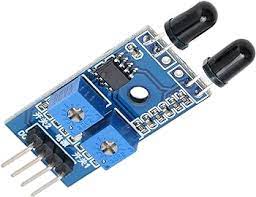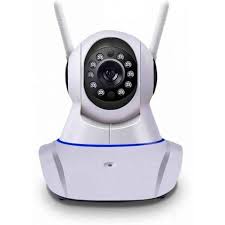Fire Sensor: A Crucial Component in Ensuring Safety
When it comes to fire safety, early detection is key. Fires can spread rapidly, causing extensive damage and posing a threat to life and property. This is where fire sensors play a vital role in safeguarding our homes, workplaces, and public spaces.
A fire sensor, also known as a smoke detector or fire alarm, is a device designed to detect the presence of smoke or fire in its vicinity. It works on the principle of optical detection or ionization. Optical sensors use infrared light to detect smoke particles, while ionization sensors rely on the electrical conductivity of smoke particles.
The importance of having fire sensors installed cannot be overstated. Here are some key reasons why they are crucial for ensuring safety:
- Early Detection: Fire sensors are designed to detect smoke or flames at their earliest stages. By promptly sensing the presence of a fire, they provide an early warning system that allows occupants to evacuate the premises before the situation escalates.
- Rapid Response: Once a fire is detected, fire sensors trigger an alarm system that alerts people nearby. This rapid response ensures that appropriate measures can be taken immediately, such as contacting emergency services and initiating evacuation procedures.
- 24/7 Monitoring: Fire sensors operate round-the-clock, providing continuous monitoring even when buildings are unoccupied or during nighttime when people are asleep. This constant vigilance ensures that any potential fires are detected regardless of the time of day.
- Enhanced Safety Measures: Fire sensors can be integrated with other safety systems such as sprinklers and emergency lighting. In case of a fire outbreak, these interconnected systems work together to minimize damage and facilitate safe evacuation.
- Prevention of False Alarms: Modern fire sensors employ advanced technologies that help reduce false alarms caused by cooking fumes or steam from showers. This ensures that alarms are only triggered when there is an actual threat present.
- Compliance with Regulations: Many countries and local authorities have stringent fire safety regulations that mandate the installation of fire sensors in certain types of buildings. By adhering to these regulations, property owners can ensure the safety of occupants and avoid legal consequences.
- Peace of Mind: Knowing that your home or workplace is equipped with reliable fire sensors provides peace of mind. It allows you to focus on your daily activities without constantly worrying about the potential risk of a fire outbreak.
In conclusion, fire sensors are an indispensable component in any comprehensive fire safety system. Their ability to detect smoke or flames at an early stage enables swift action, preventing catastrophic consequences and saving lives. Investing in quality fire sensors is a proactive step towards creating a safer environment for ourselves and those around us.
7 Essential Tips for Fire Sensor Maintenance and Safety
- Regularly inspect and test your fire sensors to ensure they are working properly.
- Replace batteries in fire sensors every 6 months or as recommended by the manufacturer.
- Place fire sensors in areas where smoke is most likely to accumulate, such as near kitchens, bedrooms, and living rooms.
- Avoid placing fire sensors near windows or doors that can be opened frequently, as this may cause false alarms.
- Clean dust from the sensor regularly to prevent it from interfering with its operation and accuracy of detection.
- Install a carbon monoxide detector in addition to a fire sensor for added safety against deadly gases that may not be detected by the smoke alarm alone.
- Make sure all family members know how to respond when an alarm sounds and have an escape plan ready if needed
Regularly inspect and test your fire sensors to ensure they are working properly.
Regularly Inspect and Test Your Fire Sensors for Optimal Safety
When it comes to fire safety, having fire sensors installed is just the first step. To ensure their effectiveness in detecting fires and providing early warnings, it is crucial to regularly inspect and test these devices. Here’s why this simple tip is so important:
- Functionality Check: Regular inspection and testing allow you to verify that your fire sensors are in proper working condition. Over time, dust, debris, or even insects may accumulate inside the sensors, affecting their performance. By conducting routine checks, you can ensure that they are free from any obstructions or damage.
- Early Detection Assurance: Fire sensors are designed to detect smoke or flames at their earliest stages. However, if they are not functioning correctly, they may fail to provide timely warnings in case of a fire outbreak. By inspecting and testing them regularly, you can have peace of mind knowing that they will function as intended when needed the most.
- Battery Maintenance: Many fire sensors operate on batteries as a backup power source in case of electrical failure. Regular inspection allows you to check the battery life and replace them if necessary. This ensures that your fire sensors remain operational even during power outages.
- False Alarm Prevention: Fire sensors can sometimes trigger false alarms due to dust or other environmental factors. By conducting regular tests, you can identify any potential issues and address them promptly. This helps prevent unnecessary panic or disruption caused by false alarms.
- Compliance with Standards: Regular inspection and testing of fire sensors are often required by local regulations and safety standards. By adhering to these guidelines, you not only ensure the safety of occupants but also avoid penalties or legal consequences for non-compliance.
So how often should you inspect and test your fire sensors? It is recommended to follow the manufacturer’s guidelines for specific intervals between inspections and tests. Typically, this could range from monthly visual checks to annual comprehensive testing conducted by professionals.
Remember, fire sensors are your first line of defense against potential fire hazards. By regularly inspecting and testing them, you can ensure their proper functioning and maximize their effectiveness in safeguarding lives and property. Don’t underestimate the importance of this simple tip – it could make all the difference in an emergency situation.
Replace batteries in fire sensors every 6 months or as recommended by the manufacturer.
Regular Battery Replacement: Ensuring Reliable Fire Sensor Performance
When it comes to fire safety, one cannot underestimate the importance of properly functioning fire sensors. These devices act as our first line of defense against potential fires, providing early detection and warning. To ensure their optimal performance, it is crucial to prioritize regular battery replacement.
Fire sensors are typically powered by batteries, and these batteries play a critical role in maintaining the device’s functionality. Here’s why replacing them every six months or as recommended by the manufacturer is essential:
- Sustained Power Supply: Fire sensors rely on a constant power supply to operate effectively. By replacing the batteries regularly, you ensure that the sensor remains powered at all times, ready to detect any signs of smoke or fire.
- Uninterrupted Monitoring: Regular battery replacement helps prevent unexpected power failures in fire sensors. This ensures uninterrupted monitoring, allowing the device to continuously scan for potential fire hazards and provide timely alerts when needed.
- Reliable Early Warning System: Fire sensors are designed to detect fires at their earliest stages, giving occupants ample time to evacuate safely. By replacing batteries as recommended, you enhance the reliability of this early warning system and increase the chances of preventing major damage or injuries.
- Adherence to Manufacturer Guidelines: Manufacturers often provide specific recommendations regarding battery replacement intervals for their fire sensor models. Following these guidelines ensures that you are maintaining your device in line with its intended specifications, maximizing its effectiveness.
- Avoiding Battery Degradation: Over time, batteries can degrade due to factors like temperature fluctuations or prolonged use. By replacing them regularly, you minimize the risk of degraded batteries impacting the performance of your fire sensor.
- Peace of Mind: Knowing that your fire sensors have fresh batteries installed brings peace of mind. It eliminates concerns about potential battery failures compromising your safety measures and allows you to trust in the reliability of your fire detection system.
Remember that while a six-month interval is a general guideline, it’s important to refer to the manufacturer’s recommendations specific to your fire sensor model. Additionally, always opt for high-quality batteries that are suitable for use in fire sensors.
In conclusion, regular battery replacement is a simple yet crucial maintenance task that ensures the reliable performance of fire sensors. By prioritizing this practice every six months or as advised by the manufacturer, you can have confidence in the effectiveness of your fire safety measures and protect yourself and others from potential fire hazards.
Place fire sensors in areas where smoke is most likely to accumulate, such as near kitchens, bedrooms, and living rooms.
Strategic Placement of Fire Sensors: Ensuring Effective Fire Detection
When it comes to fire safety, the placement of fire sensors plays a crucial role in their effectiveness. To maximize their potential, it is important to strategically position fire sensors in areas where smoke is most likely to accumulate.
Kitchens, bedrooms, and living rooms are among the spaces where smoke can quickly build up in the event of a fire. Placing fire sensors near these areas ensures that any signs of smoke or flames are detected promptly, allowing for swift action to be taken.
In the kitchen, where cooking activities generate heat and produce smoke, placing a fire sensor near the cooking area is essential. This ensures that even if you are momentarily distracted while cooking, the sensor will detect any potential hazards before they escalate into a full-blown fire.
Bedrooms are another critical area where fire sensors should be installed. People spend a significant amount of time sleeping in their bedrooms, which makes early detection of fires crucial for their safety. By placing a fire sensor in or near bedrooms, occupants can receive timely warnings and have sufficient time to evacuate safely.
Living rooms, being central gathering spaces in most homes, also require careful consideration when it comes to sensor placement. Whether it’s due to faulty electrical appliances or accidental mishaps like knocked-over candles or overloaded power sockets, fires can start unexpectedly. Having a fire sensor positioned nearby ensures that any signs of smoke or flames are detected swiftly.
Apart from these key areas, it is advisable to install additional fire sensors in hallways and stairwells as well. These locations serve as important escape routes during emergencies and having sensors placed along these paths helps ensure that any potential threats are detected along the way.
Remember that proper maintenance and regular testing of fire sensors are essential to ensure their optimal functionality. It is recommended to follow manufacturer guidelines for maintenance procedures and testing intervals.
By strategically placing fire sensors in areas prone to smoke accumulation such as kitchens, bedrooms, and living rooms, we can significantly enhance our fire safety measures. These simple yet effective precautions can provide early warnings, giving us the precious time needed to respond appropriately and safeguard ourselves, our loved ones, and our property from the devastating effects of fire.
Avoid placing fire sensors near windows or doors that can be opened frequently, as this may cause false alarms.
Fire Sensor Placement: Avoiding False Alarms
When it comes to installing fire sensors, proper placement is crucial for their effective operation. One important tip to remember is to avoid placing fire sensors near windows or doors that can be opened frequently. This simple precaution can help prevent false alarms and ensure the smooth functioning of your fire safety system.
Windows and doors that are frequently opened can create air currents or drafts. These air movements can disrupt the normal functioning of fire sensors, leading to false alarms. For example, if a sensor is placed near a window that is regularly opened for ventilation, the incoming breeze may carry dust particles or other airborne substances into the sensor’s detection area. This can trigger an alarm even when there is no actual fire.
To avoid such false alarms, it is advisable to place fire sensors away from areas with high air movement. Instead, opt for locations that are relatively stable in terms of airflow. Interior walls or ceilings away from windows and doors are generally suitable positions for sensor placement.
Additionally, consider the layout and usage patterns of your space when deciding on sensor placement. For instance, if you have a kitchen where cooking activities generate smoke or steam, it is recommended to install a separate heat or smoke detector specifically designed for kitchen environments. This specialized detector will be more resistant to false alarms caused by cooking fumes.
By taking these precautions and carefully considering the placement of fire sensors in your premises, you can minimize the risk of false alarms and ensure that your fire safety system functions optimally when it matters most. Remember, accurate detection is essential in providing timely warnings and protecting lives and property from the devastating effects of fires.
Clean dust from the sensor regularly to prevent it from interfering with its operation and accuracy of detection.
Maintaining Fire Sensor Accuracy: The Importance of Regular Cleaning
Fire sensors are crucial devices that provide early detection of smoke or fire, ensuring the safety of occupants and minimizing damage. However, to ensure their optimal performance, it is essential to regularly clean the sensors and remove any accumulated dust or debris.
Dust particles can accumulate on the surface of fire sensors over time, hindering their ability to detect smoke accurately. This can lead to false alarms or, even worse, a delayed response during an actual fire emergency. Regular cleaning helps maintain the sensor’s sensitivity and ensures its accuracy in detecting potential hazards.
Here are a few reasons why regular cleaning of fire sensors is important:
Uninterrupted Functionality: Dust accumulation on fire sensors can interfere with their operation, causing them to malfunction or fail to detect smoke effectively. By cleaning the sensors regularly, we can ensure their uninterrupted functionality and reliable performance when it matters most.
Prevention of False Alarms: Dust particles on the sensor surface can trigger false alarms by mimicking the presence of smoke. This not only causes unnecessary panic but also leads to complacency among occupants if false alarms become frequent. Regular cleaning helps reduce false alarms and ensures that genuine emergencies are promptly identified.
Enhanced Safety Measures: Clean sensors provide accurate readings, enabling early detection of fires and facilitating swift evacuation procedures. By removing dust from the sensor, we enhance the overall effectiveness of our fire safety system and improve our ability to respond effectively in emergency situations.
Prolonged Lifespan: Dust accumulation can affect the longevity of fire sensors by obstructing their internal components or causing overheating issues. Regular cleaning helps prevent these problems, extending the lifespan of the sensor and reducing maintenance costs in the long run.
To clean a fire sensor effectively:
Turn off power: Before starting any cleaning process, ensure that power to the sensor is turned off to avoid accidental triggering of alarms or electrical hazards.
Use appropriate tools: Use a soft, lint-free cloth or a small brush to gently remove dust from the sensor’s surface. Avoid using abrasive materials or excessive force that could damage the sensor.
Be thorough: Pay attention to all areas of the sensor, including vents and openings, where dust tends to accumulate. Ensure that no debris is left behind after cleaning.
Follow manufacturer guidelines: Refer to the manufacturer’s instructions for specific cleaning recommendations and any precautions to be taken.
By incorporating regular cleaning into our fire safety maintenance routine, we can ensure that our fire sensors remain accurate, reliable, and effective in detecting potential hazards. This simple yet crucial step contributes significantly to maintaining a safe environment for ourselves and those around us.
Install a carbon monoxide detector in addition to a fire sensor for added safety against deadly gases that may not be detected by the smoke alarm alone.
Enhancing Fire Safety: The Importance of Carbon Monoxide Detectors
When it comes to protecting our homes and loved ones from potential dangers, fire sensors play a crucial role. These devices are designed to detect smoke and flames, providing an early warning system in case of a fire outbreak. However, there is another silent threat that often goes unnoticed: carbon monoxide (CO) gas.
Carbon monoxide is a colorless and odorless gas that can be emitted by faulty appliances such as gas stoves, furnaces, or water heaters. It is highly poisonous and can cause serious health issues or even death if inhaled in high concentrations. Unfortunately, the symptoms of carbon monoxide poisoning are often mistaken for other illnesses, making it difficult to detect without proper equipment.
To ensure comprehensive safety against both fires and deadly gases like carbon monoxide, it is highly recommended to install a carbon monoxide detector in addition to a fire sensor. Here’s why:
- Detection of Invisible Threats: Carbon monoxide detectors are specifically designed to sense the presence of this deadly gas. They can alert you when CO levels reach dangerous levels, even before you start experiencing symptoms. This early detection allows you to take immediate action, such as ventilating the area or evacuating the premises.
- Round-the-Clock Monitoring: Similar to fire sensors, carbon monoxide detectors operate continuously, providing 24/7 monitoring for any potential leaks or buildup of CO gas. This constant vigilance ensures that you and your family are protected even while sleeping or away from home.
- Preventing Health Risks: By installing a carbon monoxide detector alongside your fire sensor, you minimize the risk of exposure to this silent killer. Prompt detection allows for timely intervention and prevents potentially life-threatening situations.
- Compliance with Safety Standards: Many countries have regulations in place that require the installation of carbon monoxide detectors in certain types of buildings or residences. By complying with these safety standards, you not only protect yourself but also ensure legal compliance.
- Peace of Mind: Knowing that you have taken additional measures to safeguard your home against both fire and carbon monoxide hazards brings peace of mind. It allows you to rest assured that you have done everything possible to protect your loved ones from these invisible threats.
In conclusion, installing a carbon monoxide detector in addition to a fire sensor is a wise decision for enhanced safety. It provides an extra layer of protection against the dangers of carbon monoxide gas, which may not be detected by the smoke alarm alone. By investing in this simple yet effective device, you are taking proactive steps towards creating a safer living environment for you and your family.
Make sure all family members know how to respond when an alarm sounds and have an escape plan ready if needed
Fire Sensor Tip: Be Prepared and Stay Safe
Having a fire sensor installed in your home is an essential step towards ensuring the safety of your family and property. However, it’s equally important to be prepared and have a plan in place for how to respond when the alarm sounds.
Here’s a valuable tip: Make sure all family members know how to respond when an alarm sounds and have an escape plan ready if needed.
When a fire sensor detects smoke or flames, it triggers an alarm system that alerts everyone in the vicinity. This is a critical moment that requires immediate action. By following these steps, you can ensure the safety of your loved ones:
- Stay calm: It’s natural to feel panicked in such situations, but it’s crucial to stay calm. Panic can hinder clear thinking and slow down your response time.
- Alert everyone: As soon as the alarm sounds, inform all family members about the potential danger. Shout out loud or use a whistle to get everyone’s attention if necessary.
- Evacuate immediately: Have an escape plan in place that includes designated meeting points outside the house where everyone should gather. Practice this plan regularly with your family so that it becomes second nature.
- Crawl low if there is smoke: In case of heavy smoke, remember to stay close to the ground where the air is less toxic. Teach children how to crawl on their hands and knees to avoid inhaling smoke.
- Feel doors before opening them: Before opening any doors during evacuation, touch them with the back of your hand. If they are hot, do not open them as this indicates fire on the other side.
- Use designated exits: Familiarize yourself with all possible exits from your home and use them accordingly during emergencies. Avoid using elevators as they may malfunction during a fire outbreak.
- Call emergency services: Once you are safely outside, call emergency services immediately to report the fire. Provide them with accurate information about the location and nature of the emergency.
Remember, preparation is key to handling any emergency effectively. Regularly review and update your escape plan as needed, considering factors like changes in the layout of your home or the addition of new family members.
By ensuring that all family members are aware of how to respond when an alarm sounds and having a well-rehearsed escape plan, you can minimize the risks associated with a fire outbreak and protect your loved ones.
Stay safe, stay prepared!




